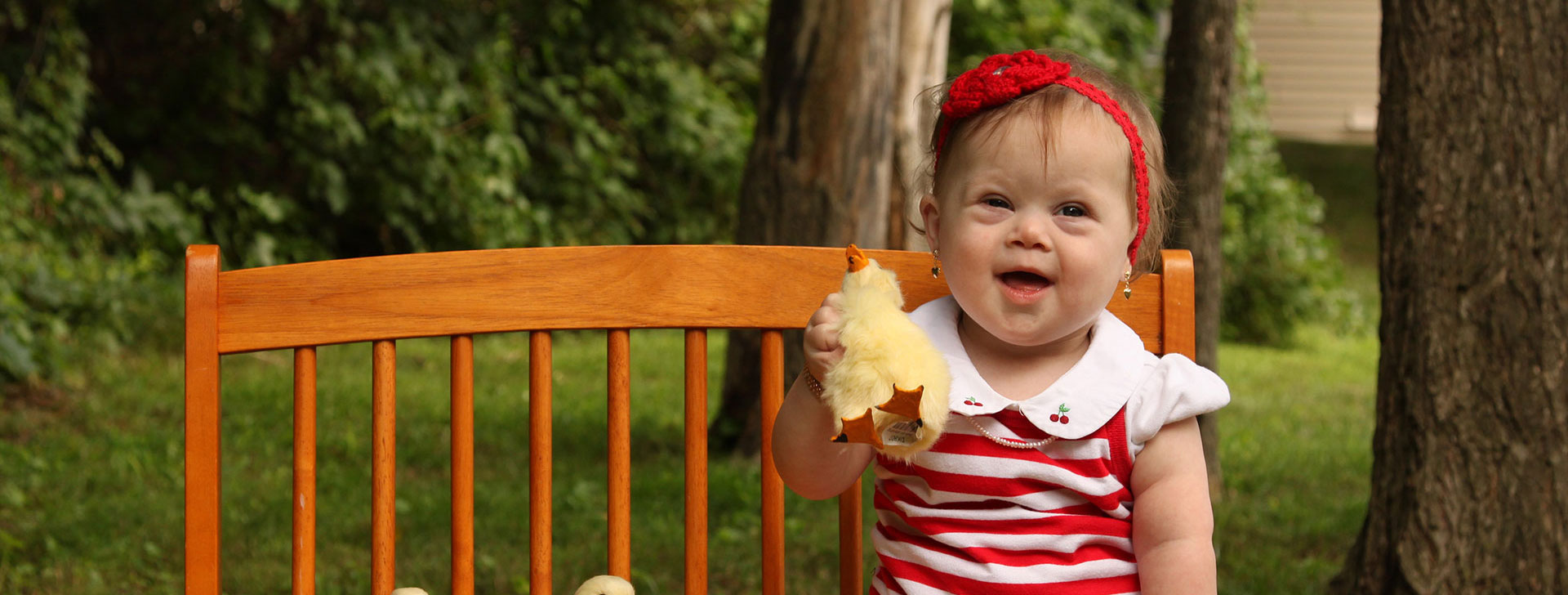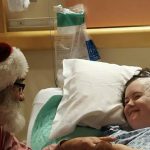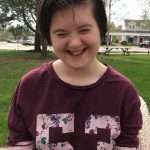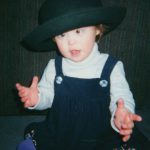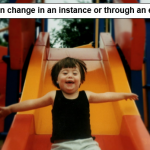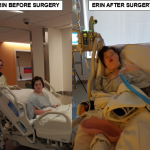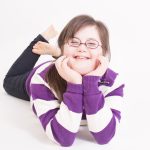Erin’s Journey with Moyamoya
Maria Dellapina
They say “Hindsight is 20/20” so let’s back up a bit. My daughter, Erin, was born in 1999 and is the youngest of my four children. At birth I was told she had Down syndrome. I was not in total shock because I had known several parents who had children with Down syndrome. They were all amazing in their own way. Still, there would be an adjustment for our family and myself. Fortunately, the nurses and pediatrician were very helpful with lots of information for the immediate future. In that moment, I vowed to do whatever it would take to raise her as a kind, smart, fun-loving individual and get her all the resources she needed to succeed.
Erin was around two years old when I noticed, repeatedly, that her eyes would cross often, especially when she was tired. As an optician by trade, I knew to schedule her an eye exam because she may need corrective eyewear. An eye exam later we found out she did. However, I could have never predicted how hard it would be to find her an eyeglass frame that properly fit. As I mentioned, I had been in the optical field for many years. Part of my job was selecting and buying frames for the office. With all my knowledge of available frames, why was it so hard to find a frame line out there to fit Erin’s unique facial features that are associated with Down syndrome? I knew, whole-heartedly, how important it was for there to be a frame to sit properly on Erin’s face and assure she would have comfortable functional glasses. My mission became to create a line of frames for my daughter and all individuals with Down syndrome, or in fact, anyone with a low flat bridge (nose). Of course, I named the frame line after my daughter and so, “Erin’s World Frames” by Specs4us (Superior Precision Eyewear for Children who are Special) would, surprisingly, become a big part of her legacy.
Overall, Erin was like any typical child. She loved playing outside, going to the movies, horseback riding, singing along to her favorite Disney soundtracks, dancing, participating in fashion shows etc., along with going to the mall and walking up into town to get ice cream. Unfortunately, Erin was only two to three years old when she had her first seizure. I remember she seemed to have a slight cold and a very low-grade fever. Eventually, I talked to the doctor and described what happened and he determined it to be a febrile seizure, which is convulsions in children caused by elevated body temperatures. Febrile seizures often cause jerky reflexes and sometimes loss of consciousness. After that initial instance, it would be a few years before I would ever see anything like that again. Then one night, when she was around 7, she came into my room calling for “Mom”. I told her to crawl in bed with me which was when I noticed how cold she felt, and she started shaking. I clutched her close and tried to warm her up. The episode seemed to end quickly. In the morning, I called a friend and told her about Erin’s “episode” last night.
A few short weeks later she came to me again in the middle of the night. Only this time the “episode” seemed more intense and lasted longer so I rushed her to the local emergency room. By the time we got there she was pretty much back to her regular self. Since we lived out in a very rural area, the hospital did not have much of a children’s unit. Luckily, we did get an EEG done. An electroencephalogram (EEG) is a non-invasive test that records electrical activity in the brain. EEGs are usually done to detect seizures and diagnose epilepsy. This EEG didn’t show anything. I did learn, later on, that if she is not experiencing a seizure during the EEG, they would be very useless for our case. This one time, we were in the children’s hospital for a 48-hour EEG that again, gave no results. We left and she had a grand-mal seizure about an hour after we were home.
Since most of these “episodes” happened in the middle of the night, I thought it was possible she was having some kind of sleep apnea. It seemed Erin had a knack for knowing when something like that was about to happen because she always came directly to me. I can’t remember exactly how many more times this happened, but it was at least seven more times. Erin’s ENT recommended we get her tonsils removed and, after her procedure, her episodes at night seemed to stop.
Throughout this time span, we were simultaneously dealing with ear infections, mostly in her left ear. Several times Erin needed to have surgery to repair her eardrum and once to remove a non-malignant tumor. Unfortunately, the surgery was scary because she had issues with anesthesia. I am referencing Erin’s ear issues because her speech seemed to be regressing and I assumed it was due to hearing loss.
February 27th, 2016, Erin called out for me as if she needed help. When I turned to her, she was trembling all over and, suddenly, fell to the floor. She was able to get back up and I took her to her favorite chair to recover. The rest of that day was pretty typical for Erin, but she seemed weak. The following Monday, I sent Erin to school with a note for her teacher explaining her unusual episode over the weekend. That afternoon, Erin came home with a note stating that she fell twice and had a headache so bad that she had to lay her head on the desk. I took Erin to the doctor. Her doctor said that the Doxycycline she was taking could cause headaches and muscle aches, so we stopped taking it, thinking this would be the remedy. On Wednesday, I received an email from a parent sharing with me that he lost his daughter three years ago. He mentioned his daughter never needed glasses but loved the mission behind Specs4Us and if his daughter had required corrective eyewear, he was thankful there was a resource readily available. I instantly wrote back thanking the father and offering my condolences. I was saddened to hear about the loss of his daughter. He soon responded to my email to tell me that his daughter passed away from a brain disease called Moyamoya and urged me to get Erin checked for it as a precaution. Since I had never heard of “Moyamoya”, my initial reaction was, “who is this person and why are you telling me this?”. However, after I googled the word, the symptoms were shockingly close to what Erin had been experiencing. The very next day, when Erin got up for school, I noticed she wasn’t acting okay. She appeared confused and unbalanced. I quickly canceled my flight to the DSAIA conference and took her to the emergency room. I frantically drove Erin to the nearest hospital with a pediatric trauma unit. I just knew my daughter’s symptoms were red flags for Moyamoya from what I read the previous day. Our first doctor disagreed. He said, “She probably has the flu, you know how that goes.”, but I didn’t. Erin had never had the flu before. So, I mentioned Moyamoya again to ease my mind. The first doctor scoffed at the mention of it, stating it was too rare to be Moyamoya. Soon after, all the flu tests came back negative. At which time, our new doctor recommended a CT Scan and the results were shocking. The scan of her brain not only showed she had a stroke on the left hemisphere, it also indicated that this was not her first stroke. The doctor said approximately a year and a half earlier she had experienced a sizable stroke on the right hemisphere as well.
Thinking back, Erin did spend 13 days in an intensive care unit with aspirated pneumonia approximately a year and a half earlier. At that time, medical staff told me she had a “panic attack” and most likely aspirated from vomiting. Now, given the results of the CT scan, that was Erin’s first stroke and could have been the initial signs of Moyamoya. No one ever recommended a CT scan or a MRI to check for a stroke because Moyamoya was not on their radar, even though signs of a stroke were present.
After the CT scan confirmed the stroke, the head doctor agreed there was a possibility of Moyamoya and told me Erin was going to be transferred to a prominent hospital’s main campus. Once we got there, they did an MRI and angiogram to confirm the presence of this disease. In the meantime, I had done a lot of research on Moyamoya and had already talked to two other moms who had children with Down syndrome who were also diagnosed with the disease. I was informed that the two best centers for Moyamoya patients were in our country: Boston Children’s Hospital with Dr. Ed Smith, head of Neurological Surgery, and Stanford Hospital with Dr. Gary Steinberg. Meanwhile, the doctors at the hospital we were taken to were not answering all my questions and seemed surprised that I had done so much of my own research. In turn, they wanted to send us home after a few days with the request for her to get rehabilitation therapy and then review her status in 4-6 months. For a mother of a sick child, this was unacceptable because I knew there were surgeries to help her condition, and it needed to be addressed immediately. Next, I requested a copy of the MRI because I had read that you can send them to Boston and Stanford for a second opinion. At first, they were not willing to let me have the copy I requested but with my oldest daughter and son with me and much convincing, we finally got a doctor to listen to us and get us the copy. My son immediately downloaded it and had it sent to both hospitals. Erin was then discharged from that medical facility and during our drive home I got a call from Dr. Ed Smith, from Boston Children’s Hospital. He requested we schedule a video chat with Erin and me for the very next day. During that video conference, it was made known that her Moyamoya was advanced, therefore, we would be going to Boston for surgery within the next 4-6 weeks.
According to Stanford University, “two types of surgical approaches are offered for patients with Moyamoya: direct and indirect revascularization. A surgical procedure in which a branch of a scalp artery is connected to a branch of the brain artery on the outer surface of the brain, providing immediate improvement in blood supply to the brain.” In Erin’s case, Dr. Smith did both revascularizations, direct on the right hemisphere and indirect on the left. The overall plan was to go to Boston the day before the surgery to have a pre-op discussion and exam with Dr. Smith. The next day we would have the surgery, stay in hospital for a couple days and eventually have a follow up appointment a week or so after returning home in Ohio.
Things don’t always go as planned.
On April 12th, 2016, Erin and I arrived in Boston to meet with Dr. Ed Smith and his team. Erin was, surprisingly, in a great mood and ready for surgery in the morning. That night, we settled into our hotel room, ordered room service and enjoyed some visual entertainment. Little did I know it would be the last time I would hear her sing the songs she loved so much.
On April 13th, we woke up a bit early and headed next door to the hospital. Erin and I talked about what was going to happen that day and she was ready. While there is no cure for Moyamoya, surgery can be successful in adding new blood flow to the brain and prolonging life. A few weeks before the surgery I had a long conversation with a parent whose son had the surgery and she filled my heart with so much hope. The surgical team came to take Erin to surgery, I walked with them as far as I could go, gave her a kiss and headed to the waiting room. I had a couple of very good friends who lived in the Boston area, and they insisted on being with me during the surgery so I would not be alone. The surgery was four or five hours long and, to be honest, the memory is still a bit of a blur because of what was to happen next. In hindsight, I wish I had kept a journal. Eventually, Dr. Smith told us the surgery went well, and Erin was in a recovery room. As he walked with us to Erin’s room, he explained more details of the surgery and mentioned he would return later that day to check on Erin. Everything was about to change.
Thankfully, Erin was awake when I went to give her a hug and she seemed to be how she typically was post-surgery. Suddenly, Erin yelled loudly and vomited. Nurses rushed in to tend to her as her monitors indicated she was having a massive stroke! My sweet daughter, my Erin, was suffering and, even worse, there was nothing I could do. I thought I was going to lose her. For the next 48 hours, time stood still while my family at home was waiting for me to call with good news. So, I had to pull myself together and make that phone call. In response, they all wanted to fly out to be with me, but I could only have one of them come because she was in the ICU. The hospital would let only one other family member have a room in the hospital commonly reserved for the parents of the other kids in the ICU. My son flew out to help me with the transition. In the meantime, more tests were completed and it was confirmed that Erin had, in fact, had another massive stroke within the left hemisphere of her brain. For the first 24 hours she was unresponsive, and the doctor wasn’t giving me much hope. I constantly prayed and talked to her with hopes she would wake up. It was over 48 hours before we saw some activity from Erin. She was awake but scared, not really understanding what was going on as she was unable to move any of her limbs: a symptom we were warned about due to the stroke. Then, a miracle! While leaning over one evening to give her a kiss she raised her left arm to give me a hug. In shock, the nurses rushed in to witness it again. Each day after, there was some form of progress and, within a few weeks, we were transferred to Spaulding, a pediatric rehabilitation center in Boston. There I learned about aphasia: A comprehension and communication (reading, speaking, or writing) disorder resulting from damage or injury to specific areas in the brain. It’s worth noting that before the surgery and stroke, Erin could read, write, spell, play games and even complete jigsaw puzzles. But now, if I were to show her a picture of something or someone familiar, she would look at me clueless. We remained in Boston until she was cleared to board a plane to fly back to Cleveland, Ohio. Once we landed, we were transferred to a children’s rehab center in Cleveland. Erin came home from rehab June 2nd, 2016, just one day before her 17th birthday.
We knew we had a long road ahead and when we returned to Boston Children’s Hospital a year later, the findings were not as we had hoped. In February of 2018, we had an appointment to go over Erin’s latest MRI & angiogram results. At this meeting, we were introduced to a palliative care doctor and were given the news that the Moyamoya disease was taking over her brain and it was shutting down. The last thing I expected that day was being asked to sign a “Do Not Resuscitate” order. Signing the DNR felt like I was giving up hope. It was the hardest thing I ever had to do.
Based on research from Dr. Ed Smith, the percentage of children with Down syndrome afflicted with Moyamoya has increased in just the last five years. I believe this growth is a result of the internet and parents, like me, who are speaking about and advocating more for Moyamoya awareness. Had I known what to watch for earlier, I could have found out much sooner, resulting in earlier preventative treatment. We, as parents, will always know our children’s behavior best and, therefore, any changes in that behavior should be brought to a doctor’s attention. I blamed my daughter’s declining speech to some of her hearing issues, without knowing it had much more to do with the TIA’s (mini strokes) she had been having for years. Shortly after her diagnosis I began speaking at Down syndrome conferences to educate parents of the signs and symptoms associated with Moyamoya, which helps with early detection. It is my hope and mission to have Down syndrome guidelines communicate the need for an MRI/angiogram as early as age five.
As for hindsight, we all say, “If I had known then what I know now”. Instead, let’s start informing others of this nasty disease and the signs of a seizure, stroke or TIA. No other parents deserve to go through what my sweet Erin and family had to endure, all because of lack of information.
Erin died on July 19th, 2019.
It is my mission now to advocate for Moyamoya awareness so this can be on everyone’s radar. In 2018 we were selected to present at the World Down syndrome conference in Scotland on Erin’s Moyamoya journey.
In her honor, our family started the Erin’s Umbrella scholarship fund which is used to send one deserving family on the Buddy Cruise each year. Buddy Cruise is a 501c3 non-profit charity providing educational opportunities and resources for families, while promoting awareness, advocacy, and inclusion for individuals with special needs. Attending this event was something Erin looked forward to each year. 2018 was her last time attending and in 2019, the cruise was dedicated to Erin’s memory and her whole family was on board. I continue to join the Buddy Cruise each year as a presenter and this year, I am proud to say, we are sending three families on this cruise.

